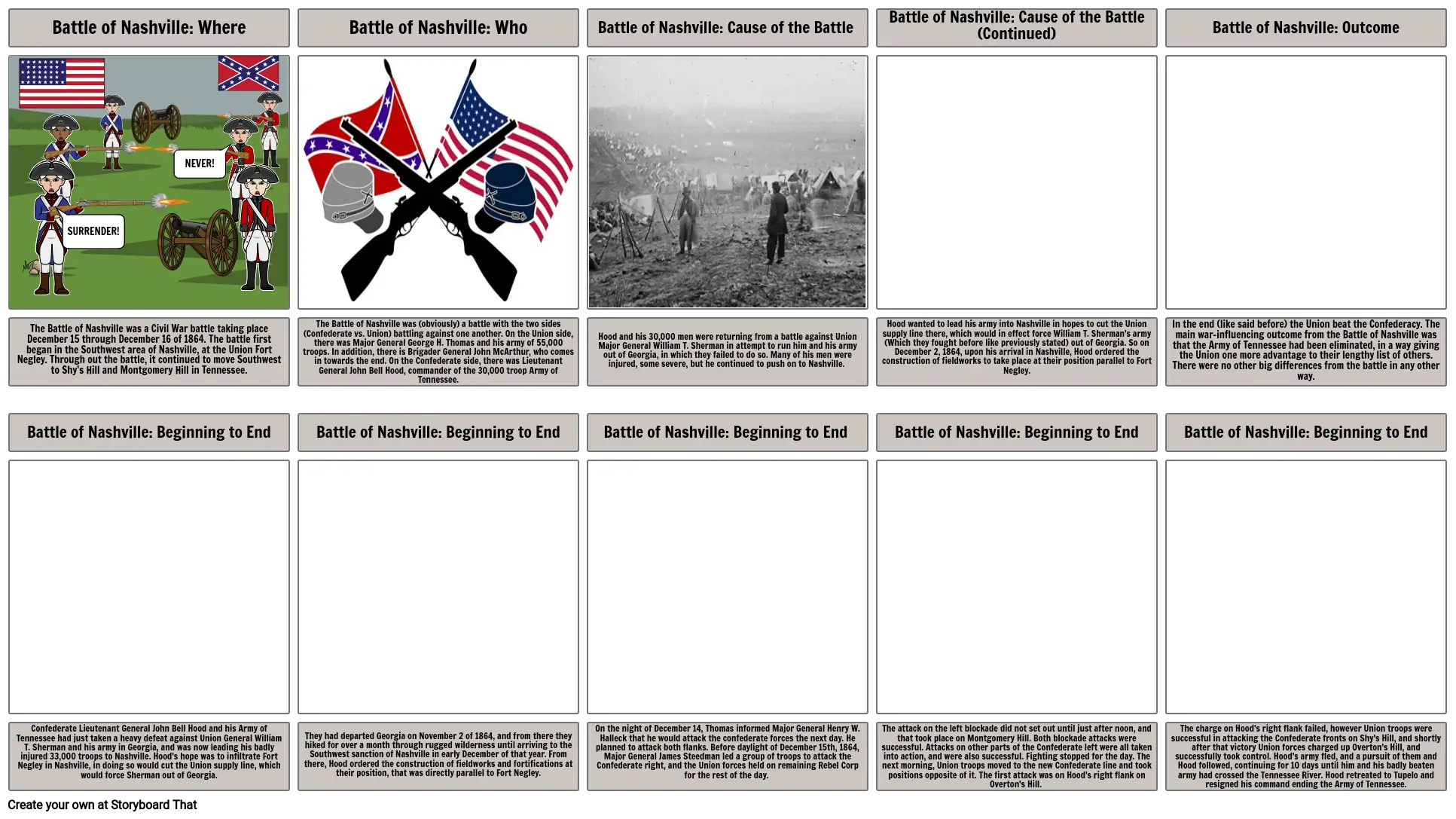Battle of Nashville- Period 4 Kniss

Storyboard Text
- Battle of Nashville: Where
- SURRENDER!
- NEVER!
- Battle of Nashville: Who
- Battle of Nashville: Cause of the Battle
- Battle of Nashville: Cause of the Battle (Continued)
- Battle of Nashville: Outcome
- The Battle of Nashville was a Civil War battle taking place December 15 through December 16 of 1864. The battle first began in the Southwest area of Nashville, at the Union Fort Negley. Through out the battle, it continued to move Southwest to Shy's Hill and Montgomery Hill in Tennessee.
- Battle of Nashville: Beginning to End
- The Battle of Nashville was (obviously) a battle with the two sides (Confederate vs. Union) battling against one another. On the Union side, there was Major General George H. Thomas and his army of 55,000 troops. In addition, there is Brigader General John McArthur, who comes in towards the end. On the Confederate side, there was Lieutenant General John Bell Hood, commander of the 30,000 troop Army of Tennessee.
- Battle of Nashville: Beginning to End
- Hood and his 30,000 men were returning from a battle against Union Major General William T. Sherman in attempt to run him and his army out of Georgia, in which they failed to do so. Many of his men were injured, some severe, but he continued to push on to Nashville.
- Battle of Nashville: Beginning to End
- Hood wanted to lead his army into Nashville in hopes to cut the Union supply line there, which would in effect force William T. Sherman's army (Which they fought before like previously stated) out of Georgia. So on December 2, 1864, upon his arrival in Nashville, Hood ordered the construction of fieldworks to take place at their position parallel to Fort Negley.
- Battle of Nashville: Beginning to End
- In the end (like said before) the Union beat the Confederacy. The main war-influencing outcome from the Battle of Nashville was that the Army of Tennessee had been eliminated, in a way giving the Union one more advantage to their lengthy list of others. There were no other big differences from the battle in any other way.
- Battle of Nashville: Beginning to End
- Confederate Lieutenant General John Bell Hood and his Army of Tennessee had just taken a heavy defeat against Union General William T. Sherman and his army in Georgia, and was now leading his badly injured 33,000 troops to Nashville. Hood's hope was to infiltrate Fort Negley in Nashville, in doing so would cut the Union supply line, which would force Sherman out of Georgia.
- They had departed Georgia on November 2 of 1864, and from there they hiked for over a month through rugged wilderness until arriving to the Southwest sanction of Nashville in early December of that year. From there, Hood ordered the construction of fieldworks and fortifications at their position, that was directly parallel to Fort Negley.
- On the night of December 14, Thomas informed Major General Henry W. Halleck that he would attack the confederate forces the next day. He planned to attack both flanks. Before daylight of December 15th, 1864, Major General James Steedman led a group of troops to attack the Confederate right, and the Union forces held on remaining Rebel Corp for the rest of the day.
- The attack on the left blockade did not set out until just after noon, and that took place on Montgomery Hill. Both blockade attacks were successful. Attacks on other parts of the Confederate left were all taken into action, and were also successful. Fighting stopped for the day. The next morning, Union troops moved to the new Confederate line and took positions opposite of it. The first attack was on Hood's right flank on Overton's Hill.
- The charge on Hood's right flank failed, however Union troops were successful in attacking the Confederate fronts on Shy's Hill, and shortly after that victory Union forces charged up Overton's Hill, and successfully took control. Hood's army fled, and a pursuit of them and Hood followed, continuing for 10 days until him and his badly beaten army had crossed the Tennessee River. Hood retreated to Tupelo and resigned his command ending the Army of Tennessee.
Over 30 Million Storyboards Created
No Downloads, No Credit Card, and No Login Needed to Try!
